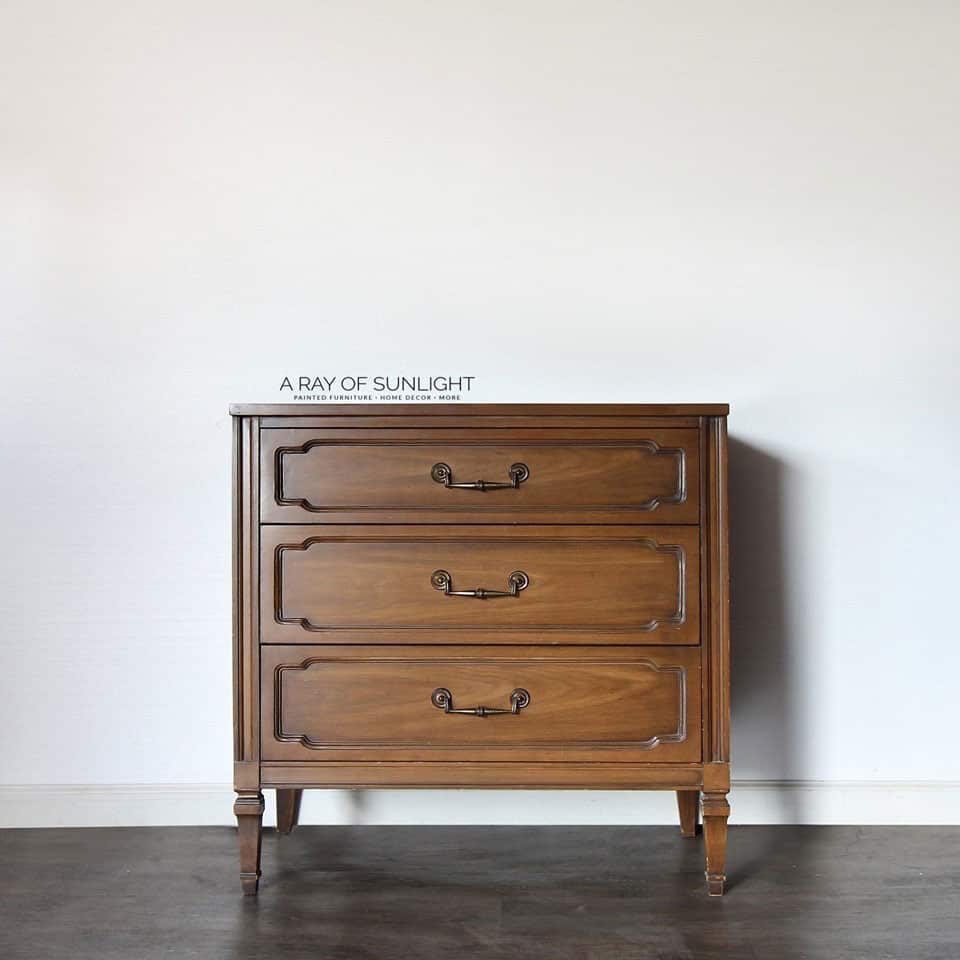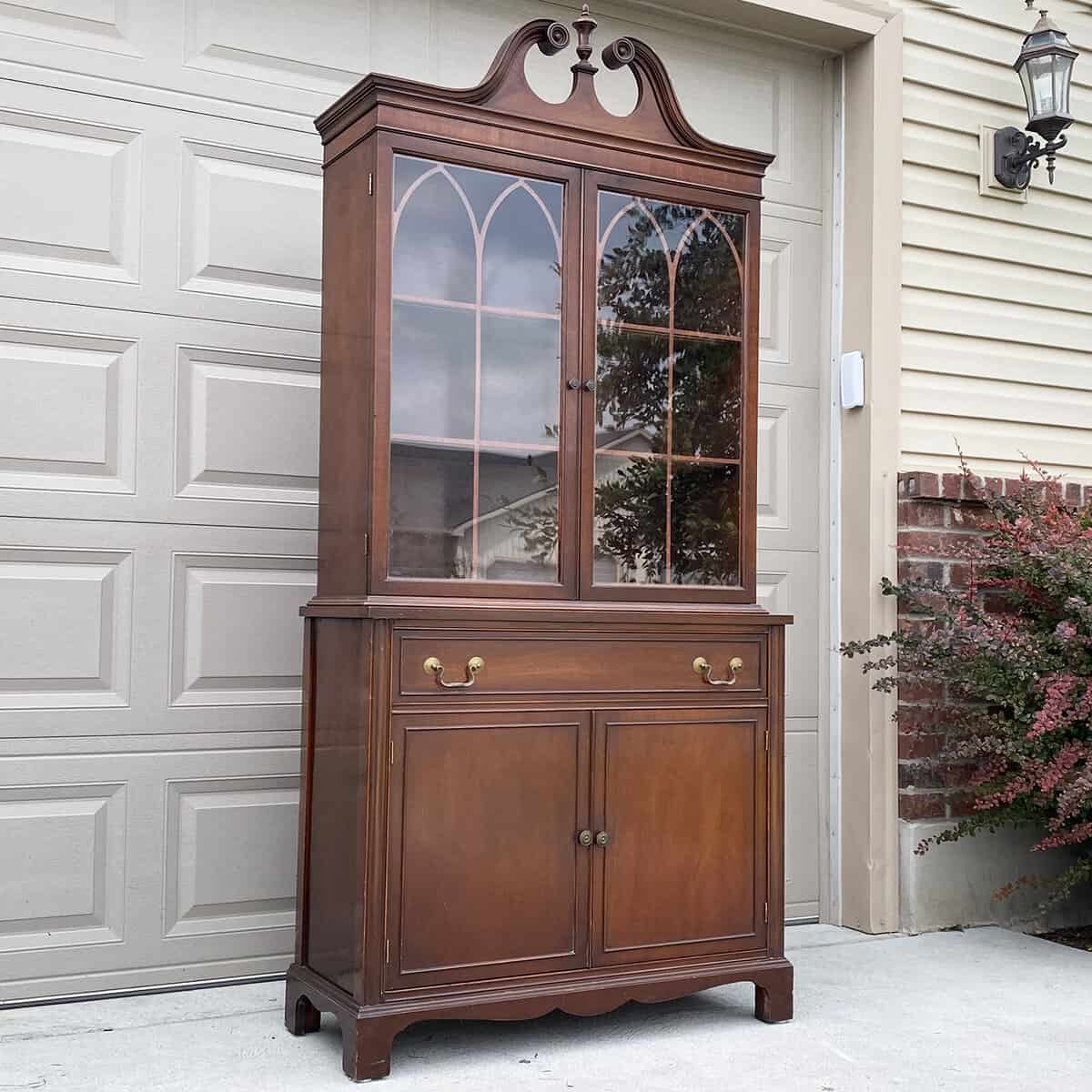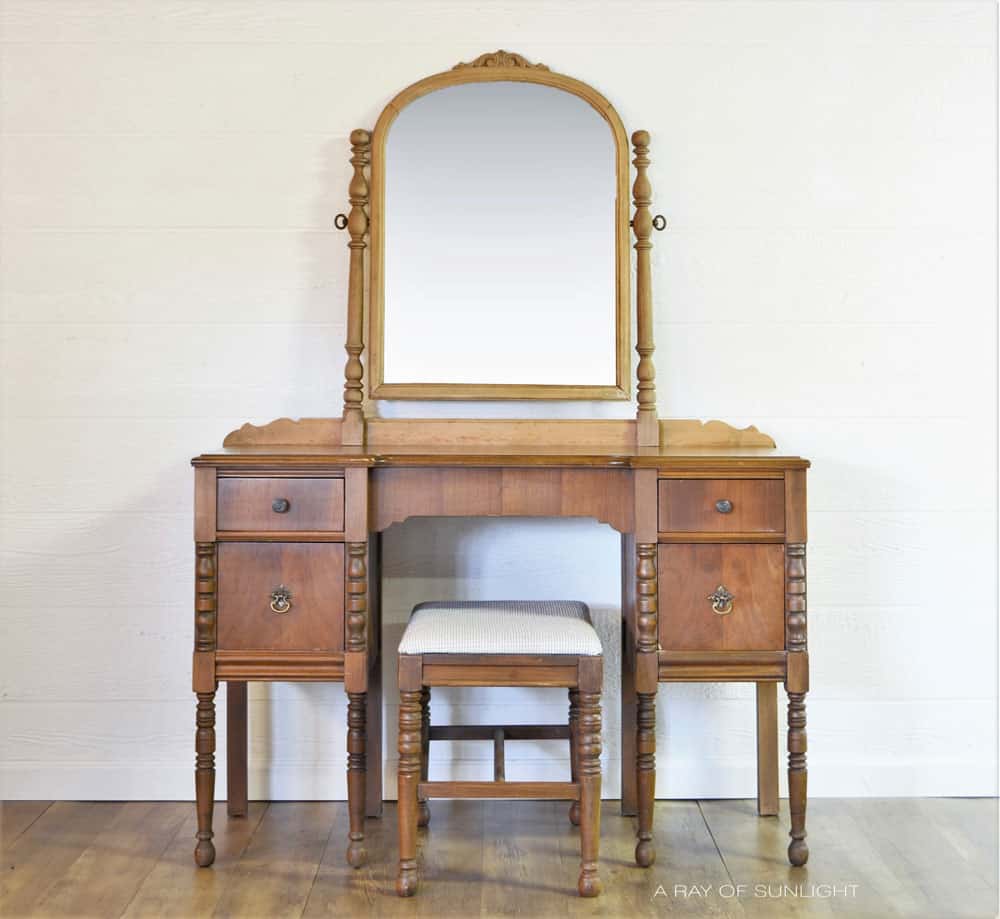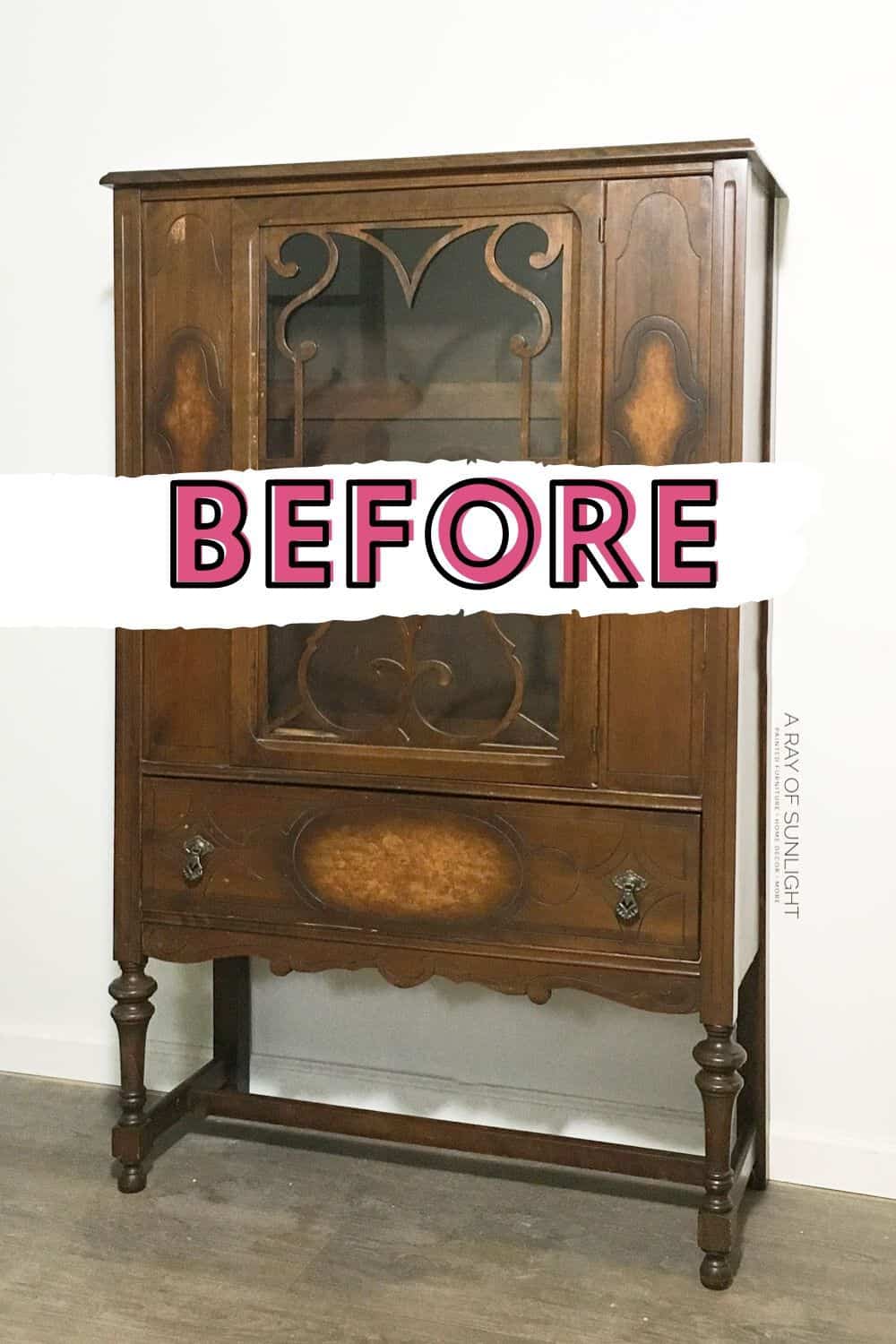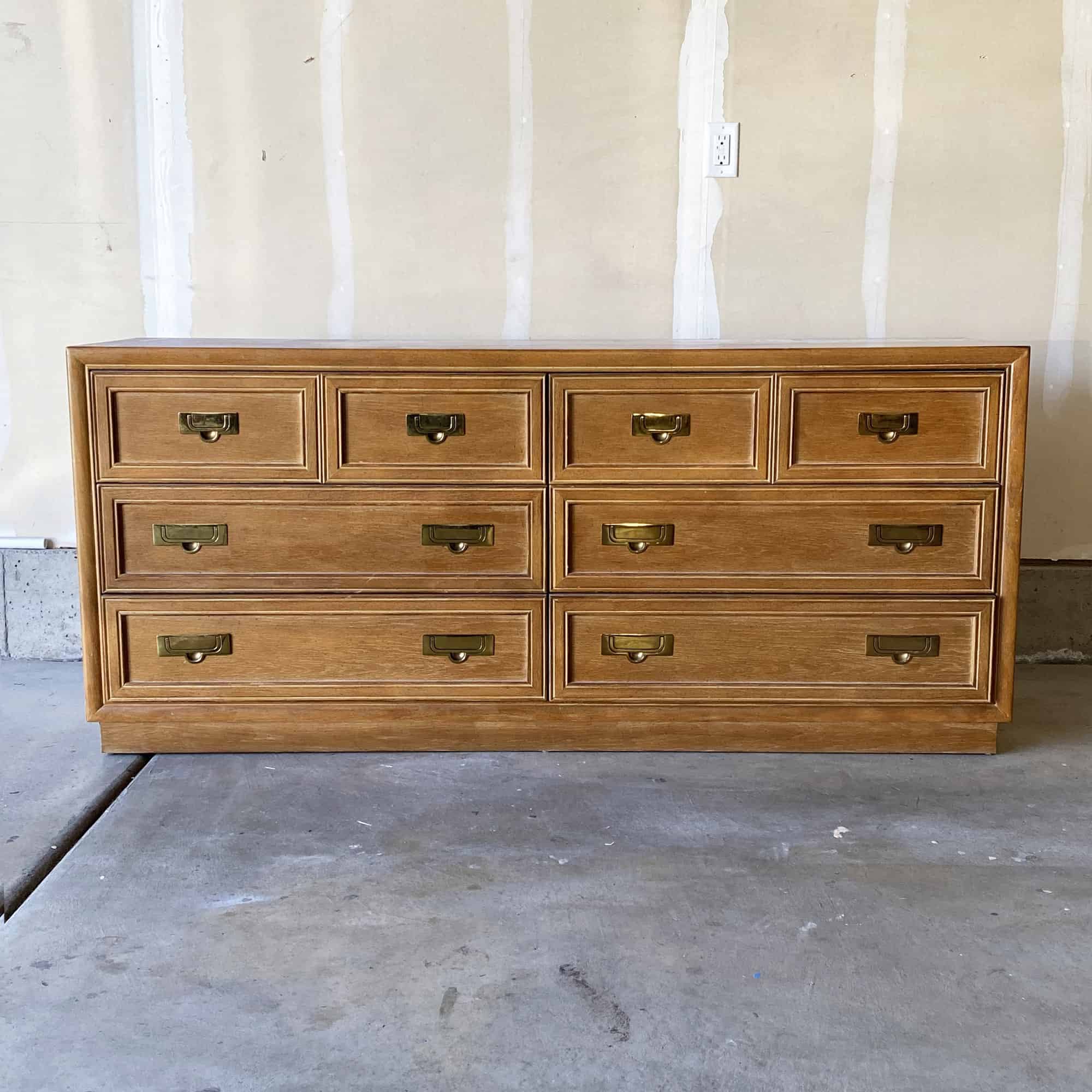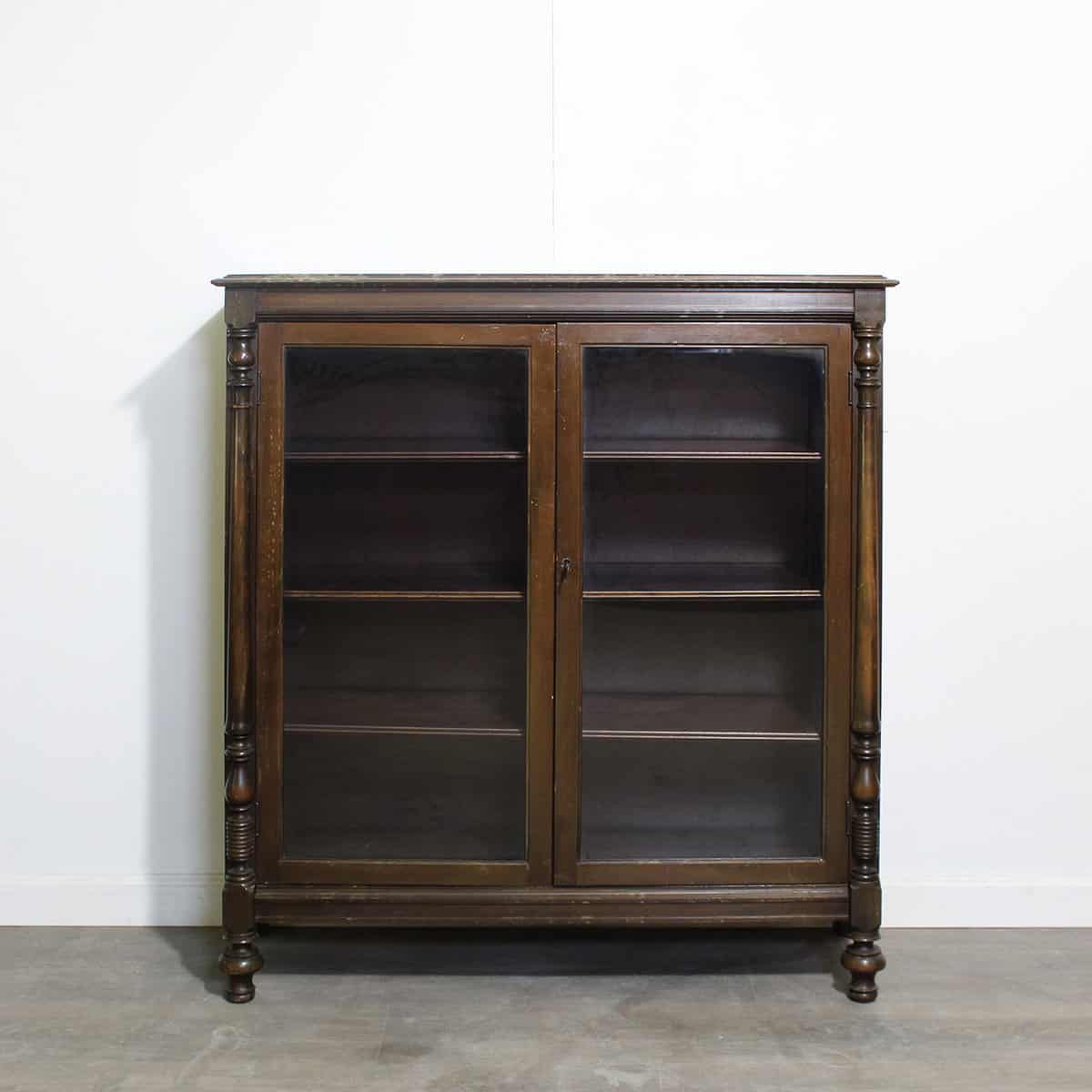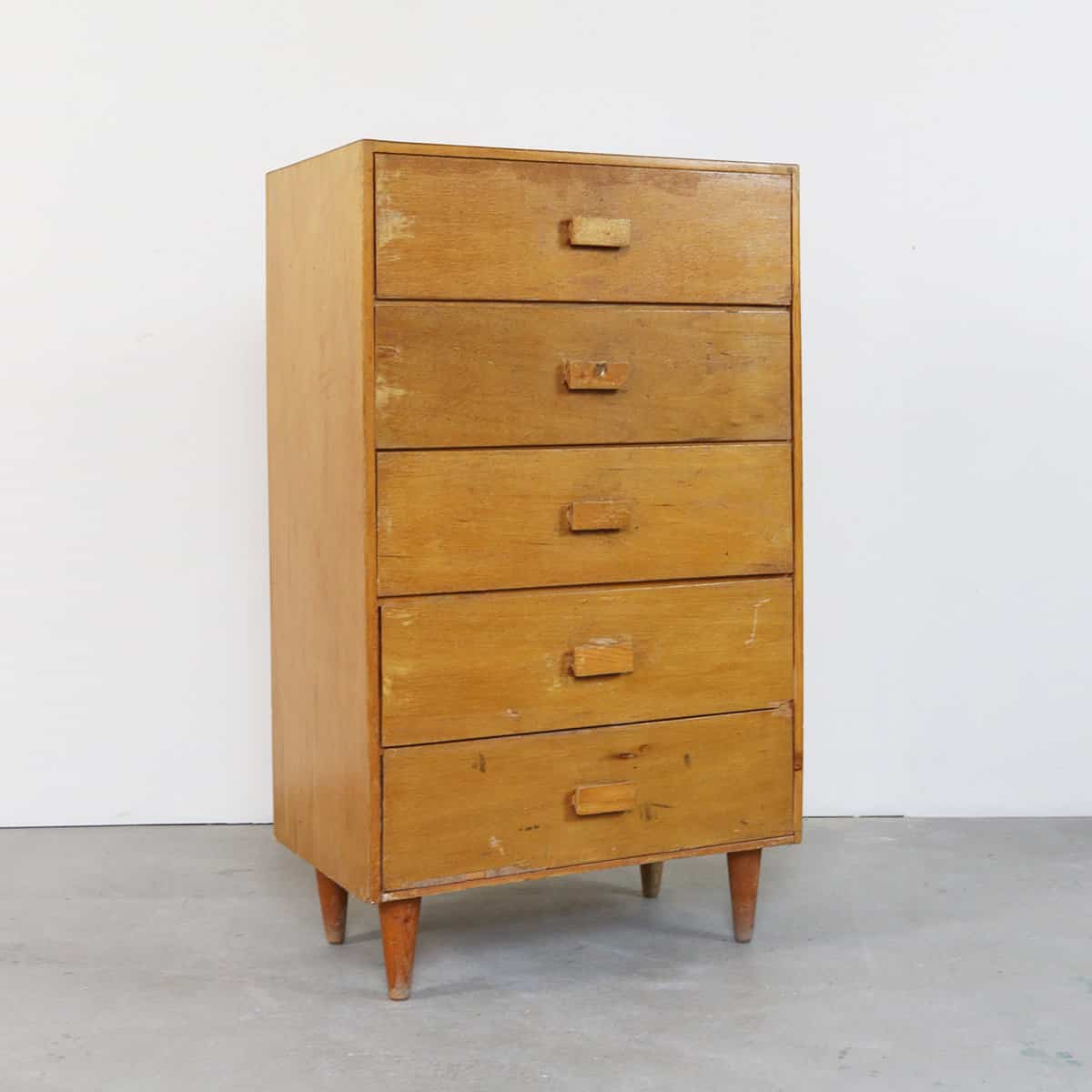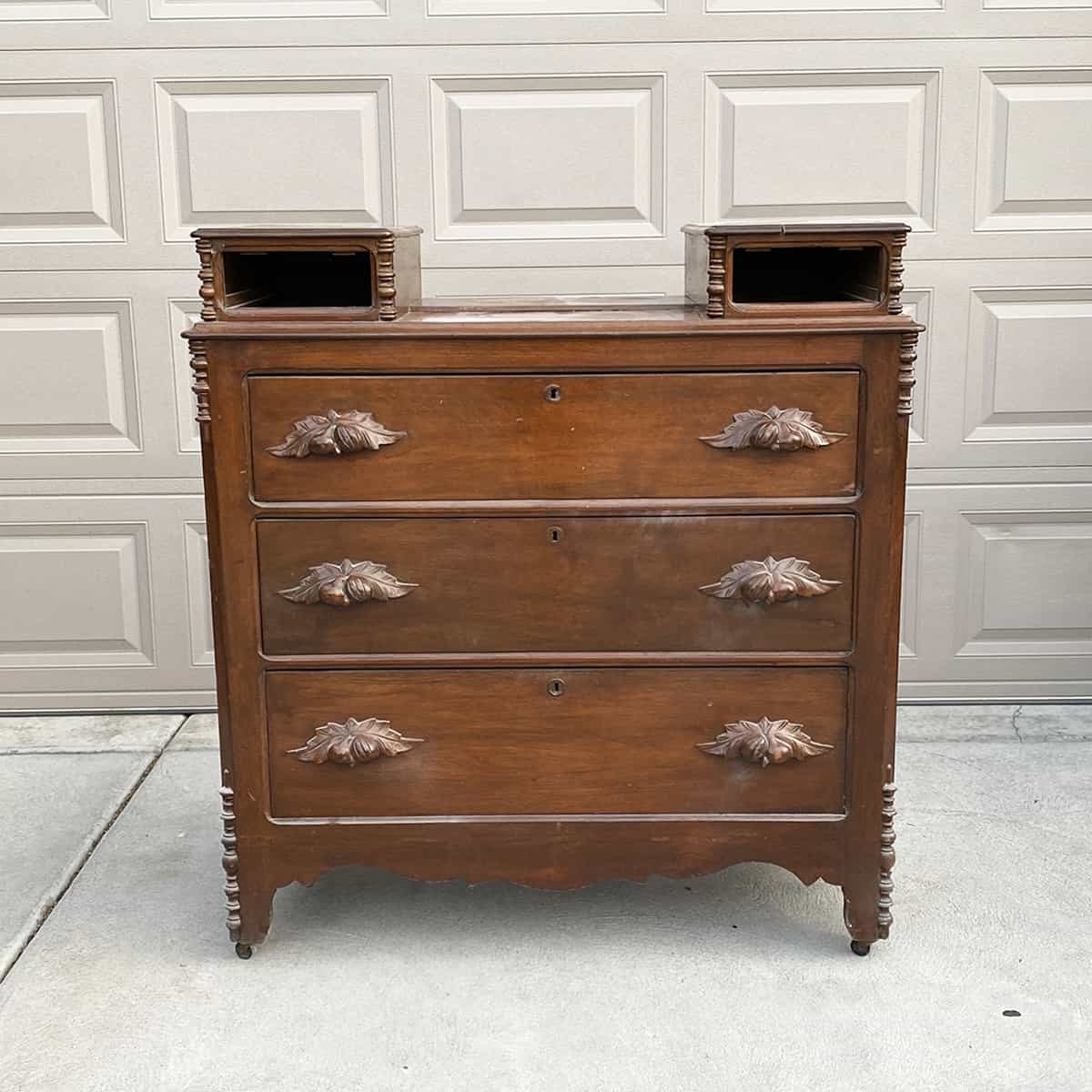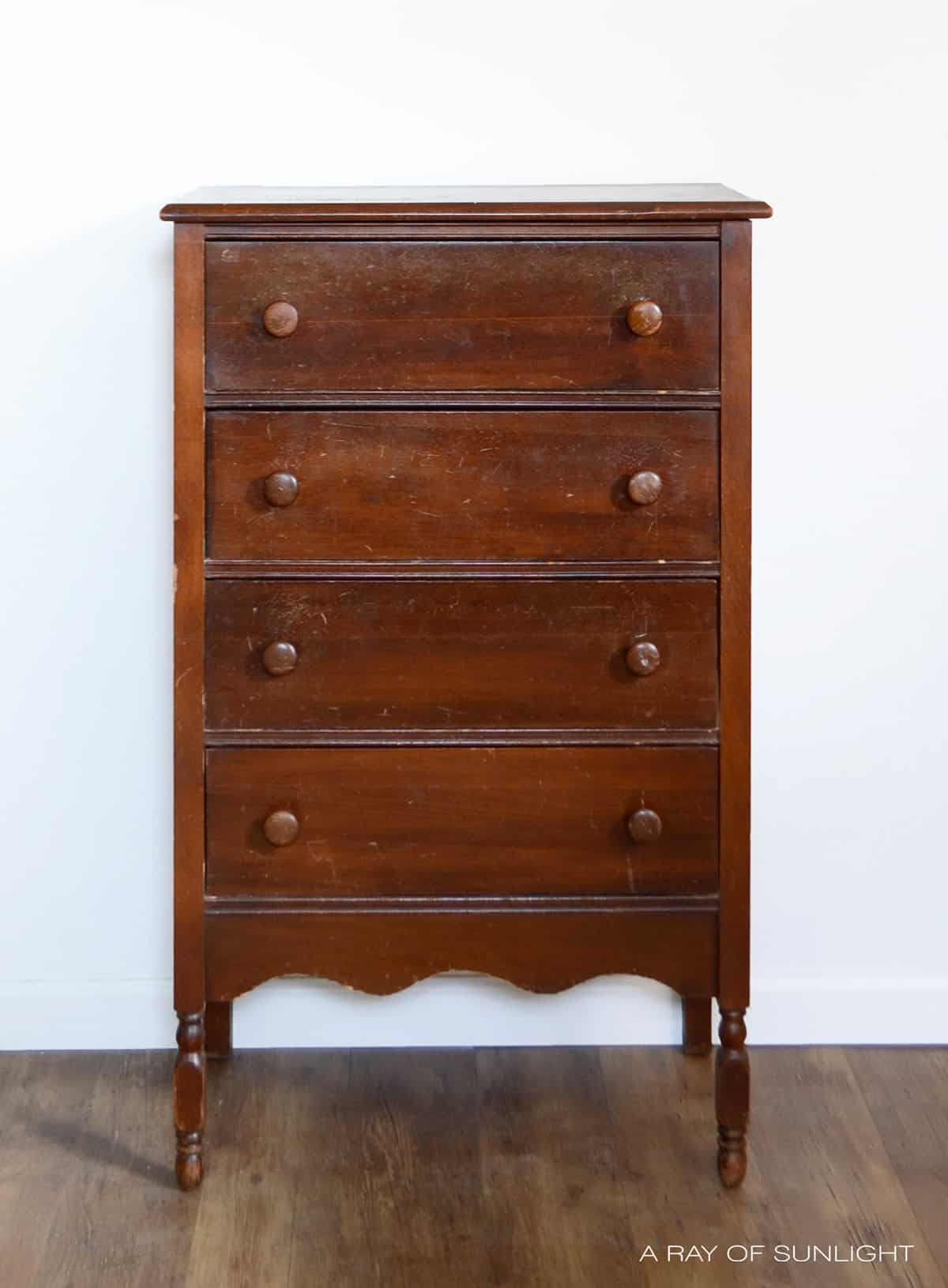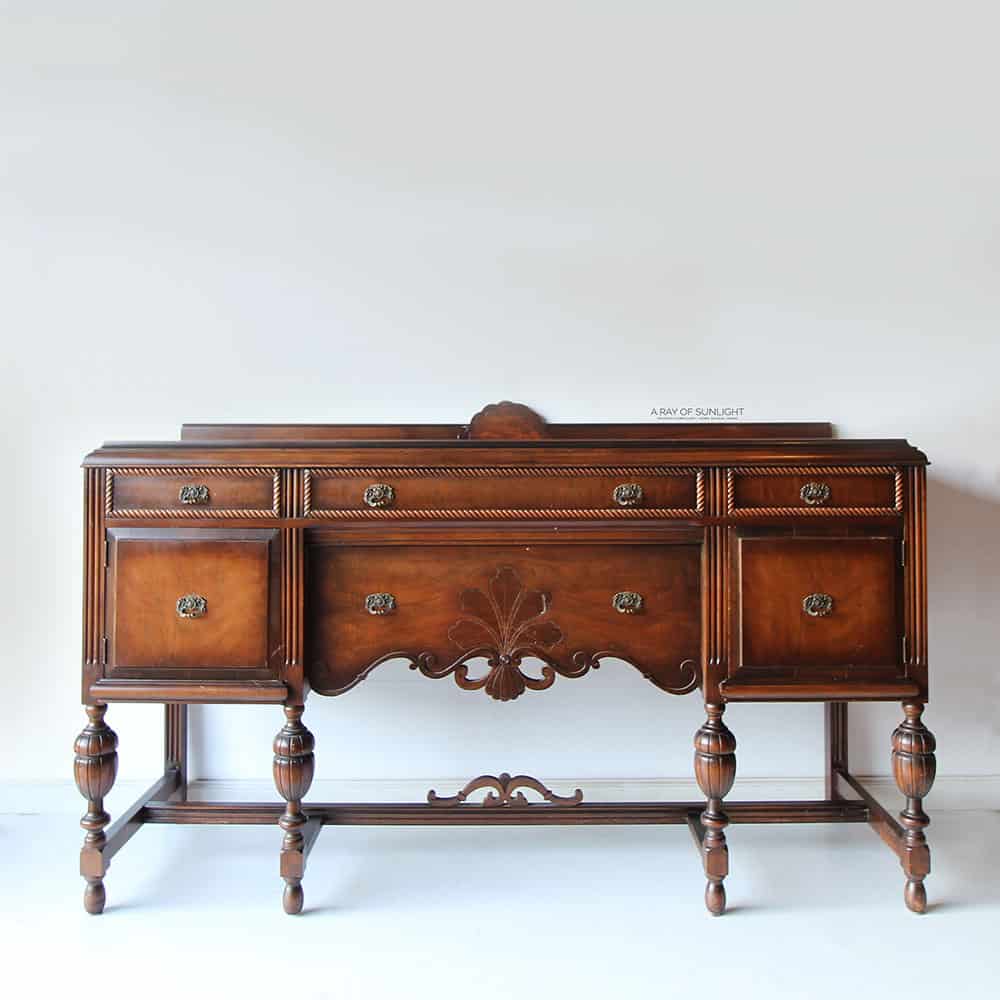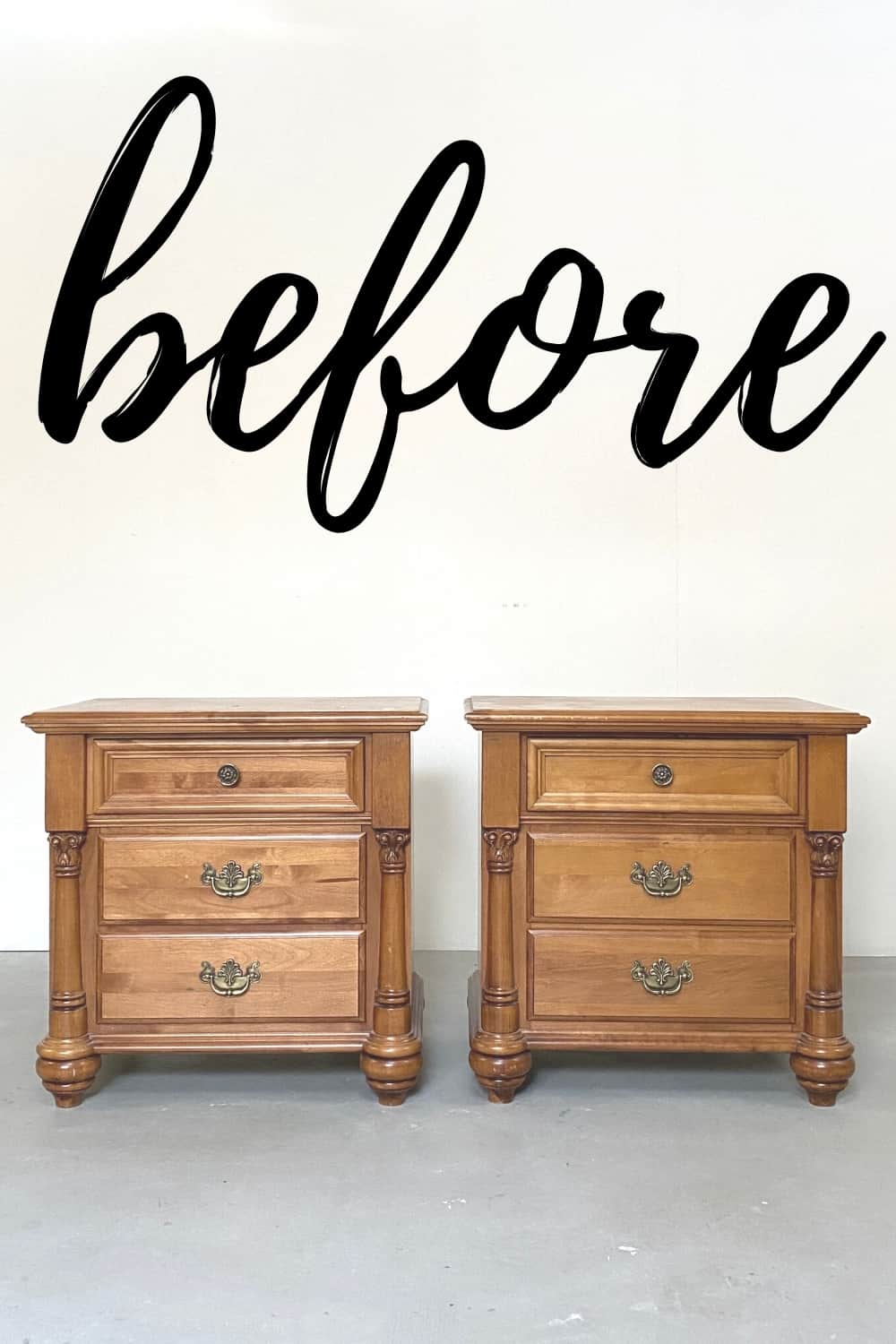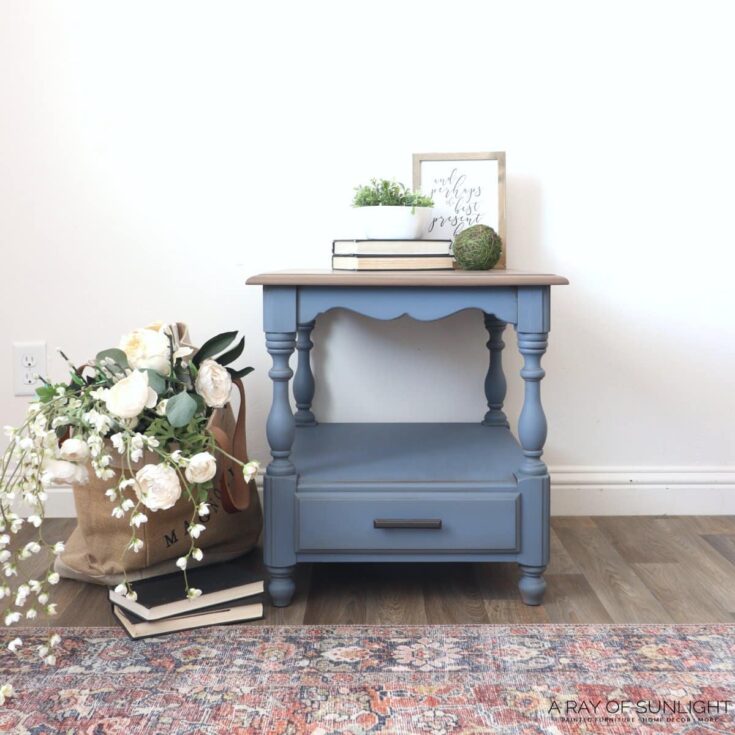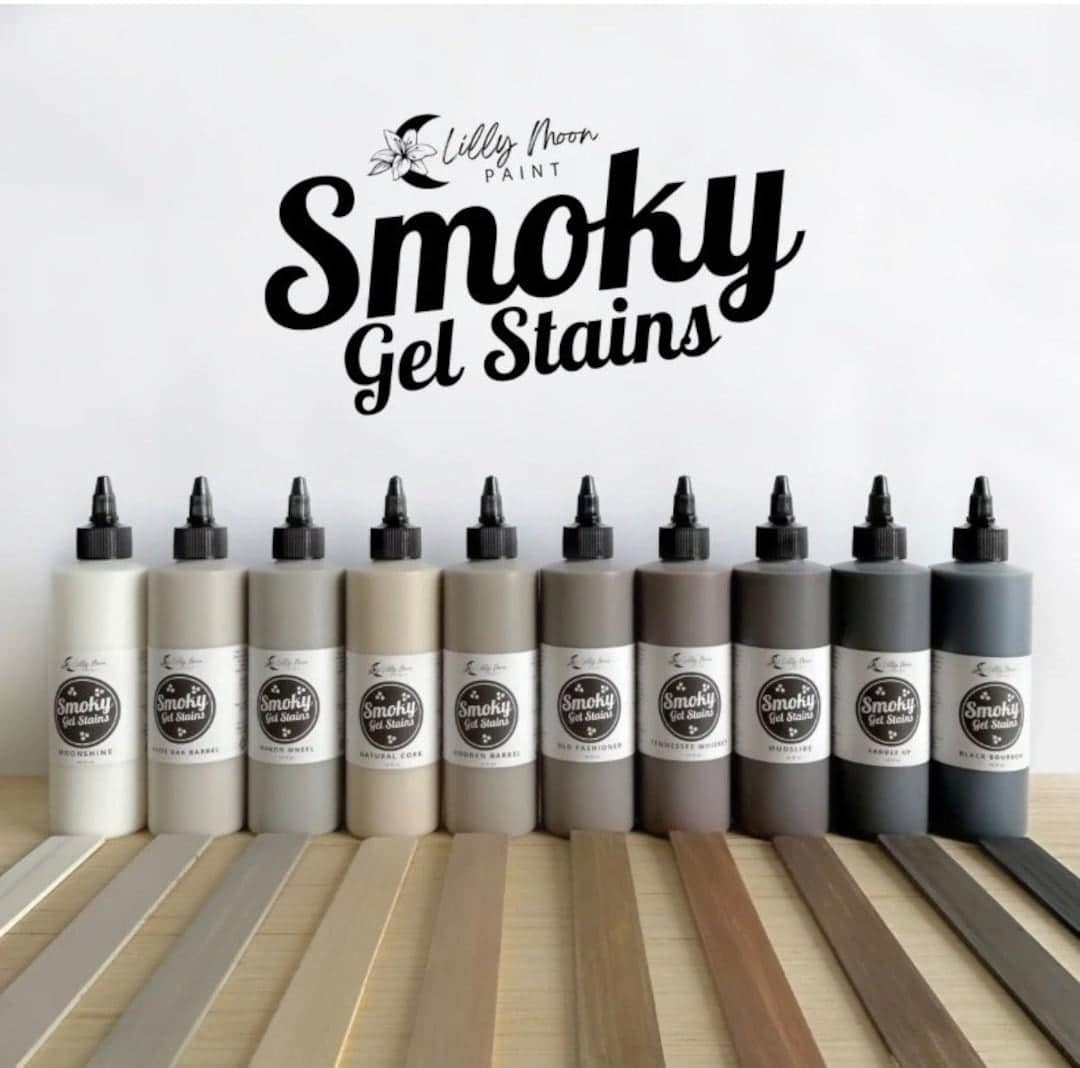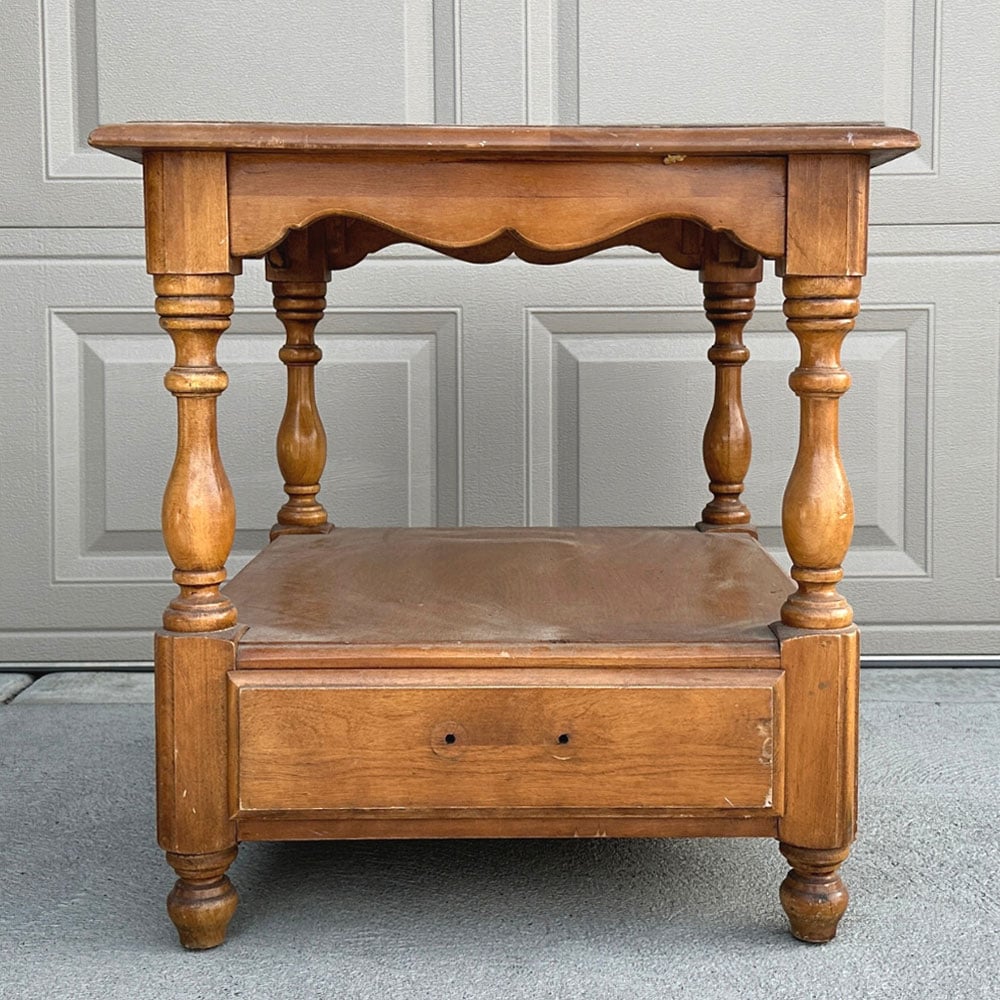How to Use Waverly Chalk Paint and Wax
Are you looking for an easy way to give your furniture a makeover? Waverly chalk paint and wax can help you achieve the look you’re after with minimal effort. In this blog post, we’ll show you how to use Waverly chalk paint in Night Sky and Waverly antique wax to transform any piece of furniture into something truly special.
With just a few simple steps, you can create your own stunning painted furniture that will last for years to come. So grab your supplies and let’s get started!
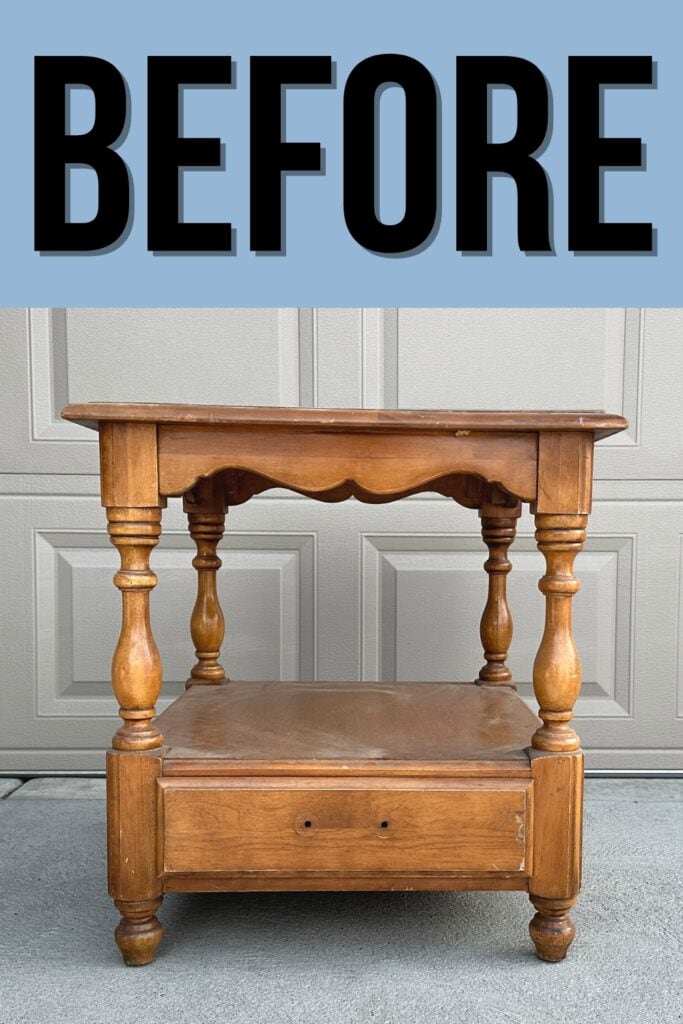
This beat up end table is getting a CHEAP paint makeover to fit its french style. We bought it from the thrift store, and it was a solid wood piece of furniture.
Have you ever wanted to give your furniture a fresh, new look? Are you tired of the same old paint job or design?
Waverly chalk paint and antique wax can help transform any piece of furniture into something truly special on a budget, with minimal effort.
In this blog post, we’ll show you how to use these two products together to create a stunning new look.
Supplies Used for Waverly Chalk Paint and Wax Makeover
As an Amazon Associate, I earn from qualifying purchases. I also may earn from other qualifying purchases with other companies or get free product to review and use. All opinions are my own.
- Krud Kutter
- Medium and Fine Grit Foam Pads (Use code RAY10 to get 10% off your order)
- SurfPrep Sander (Use code RAY10 to get 10% off your order)
- Carbide Scraper
- Interface Foam Pad (Use code RAY10 to get 10% off your order)
- 80, 120, 150 Grit Sandpaper (Use code RAY10 to get 10% off your order)
- Sanding Contour Grip
- Pre Taped Plastic
- Painters Tape
- Waverly Chalk Paint – Night Sky
- Paint Sprayer
- Clear Wax
- Chip Brush
- Lint Free Rag
- Antique Wax
- Lilly Moon Smoky Gel Stain – Old Fashioned
- Topcoat Brush
- Waterbased Polyurethane
Preparing Furniture for Paint
If any piece of furniture needed to be cleaned first, this one did. After spraying Krud Kutter on it, I used a metal scraper to remove the splattered paint and sticker.
Then I wiped the rest down, and went back over everything with a clean wet rag to make sure it was all clean. It already looked so much better at this point!!
Learn everything you need to know about how to clean furniture before painting here.
Then I put a medium grit foam pad onto the sander and lightly scuff sanded the end table to remove the glossy sheen, making a surface that the paint will be better able to stick to.
Learn about the importance of sanding before painting furniture here.
Typically, I would also suggest that you need to prime before painting furniture, even with chalk paint. This time I decided to see how well this paint will really hold up without a primer underneath.
Let’s just say that I would strongly recommend spraying a coat or two of clear shellac before painting with Waverly chalk paint if you want your paint to stick well!
Here are more of the best primers for painting furniture (and how to choose the right one).
Sanding Old Finish From Wood Furniture
The top was pretty scratched up though, so I used our carbide scraper to scrape off most of the old finish before sanding the rest off.
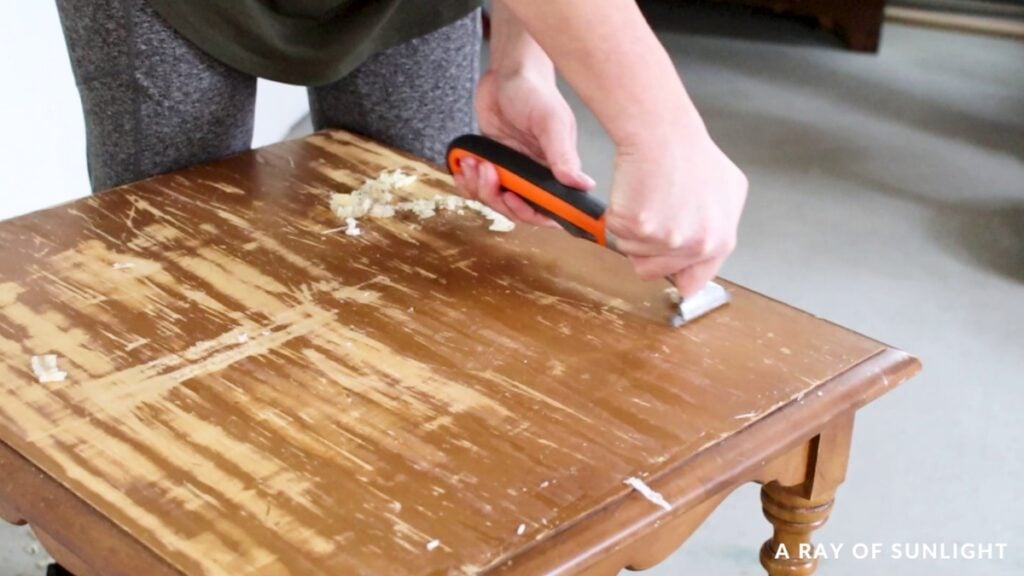
I don’t know if the blade is getting dull, or if this finish was thick, but it wasn’t as easy as normal to scratch off.
But still, I completely believe that it made the whole process go faster than if I would have only sanded or used a chemical stripper. Learn how to remove wood stain with a chemical stripper here.
For the edges, I put a thick interface foam pad onto my sander with my 80 grit sandpaper to easily sand the curves.
To get into the corner of the edges, I wrapped some sandpaper around a sanding contour grip. Learn more about how to sand in tight spaces here.
And then I sanded everything a couple of more times with 120 grit sandpaper and 150 grit sandpaper to make it all feel smoother.
This whole process took about 30 minutes from start to finish on this little top.
The inside of the drawer looked extra dirty as well, so I sanded inside of the drawer with 150 grit sandpaper to remove the pretty drawings and the stains.
From here, you can protect the inside of the drawers and look much better, check out the best material to line dresser drawers.
If your drawers were already lined and need updating, here’s how to remove contact paper from wood.
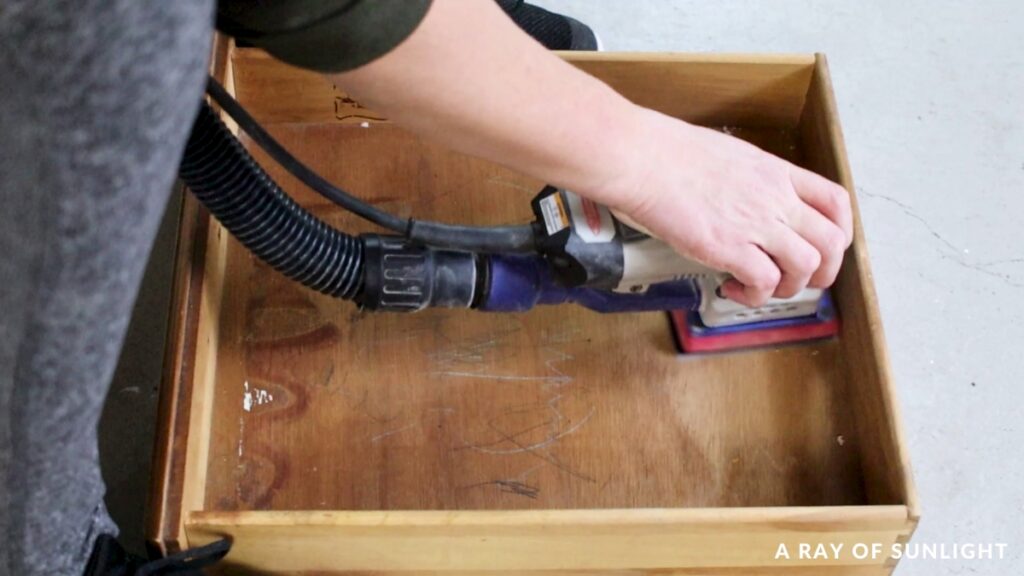
Learn more about the best sandpaper for furniture painting here.
This right here is a huge reason why I love this SurfPrep sander. The small profile and the rectangle shape made it easy to sand this tight space, clear up into the corners.
And now, the drawer looks SO fresh and clean.
How to Use Waverly Chalk Paint
Then I cleaned off all of the dust, and I taped off the raw wood top so I wouldn’t get paint on it. I used a roll of pretaped plastic and some painters tape for this.
Learn more tricks like this in this post on how to prevent overspray when painting furniture and how to prevent paint bleed through painter’s tape here.
And then I set up my spray paint booth by laying some plastic on the ground, and some old cardboard on top of it.. and then my handy 5 gallon buckets for the table to sit on top of.
This time, I wanted to quickly paint the end table, so I put the cheap Waverly chalk paint in the Night Sky color into my paint sprayer.
This paint is THICK! So I added quite a bit of water to it. I would guess at least 20% water to paint ratio here.
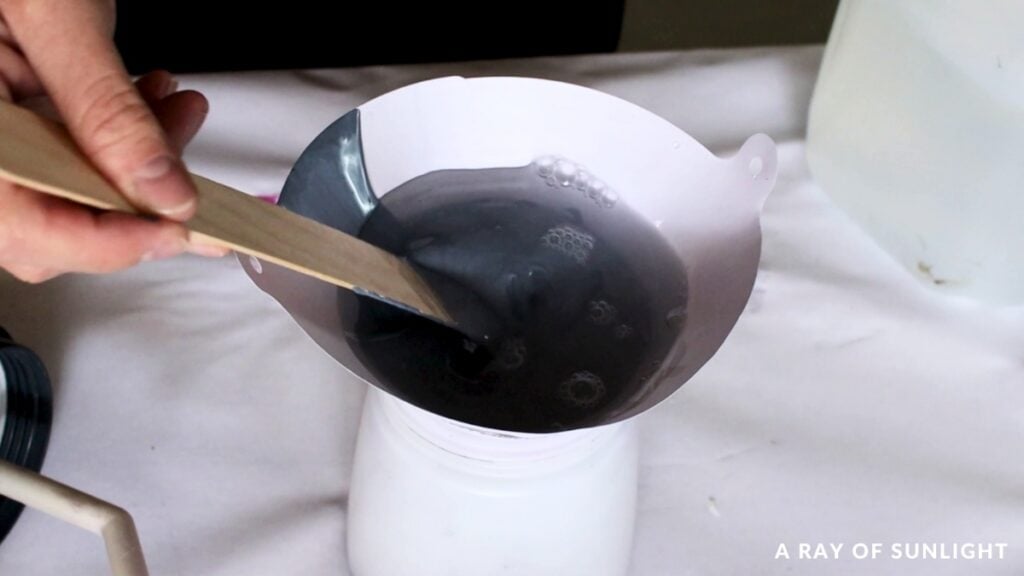
Learn more about how to thin paint for Wagner FLEXiO sprayer here. And learn how to use the Wagner FLEXiO paint sprayer here.
When I sprayed it, it had a lot of fish eye texture in it. If I would have primed before painting, I would have gotten better results in the end.
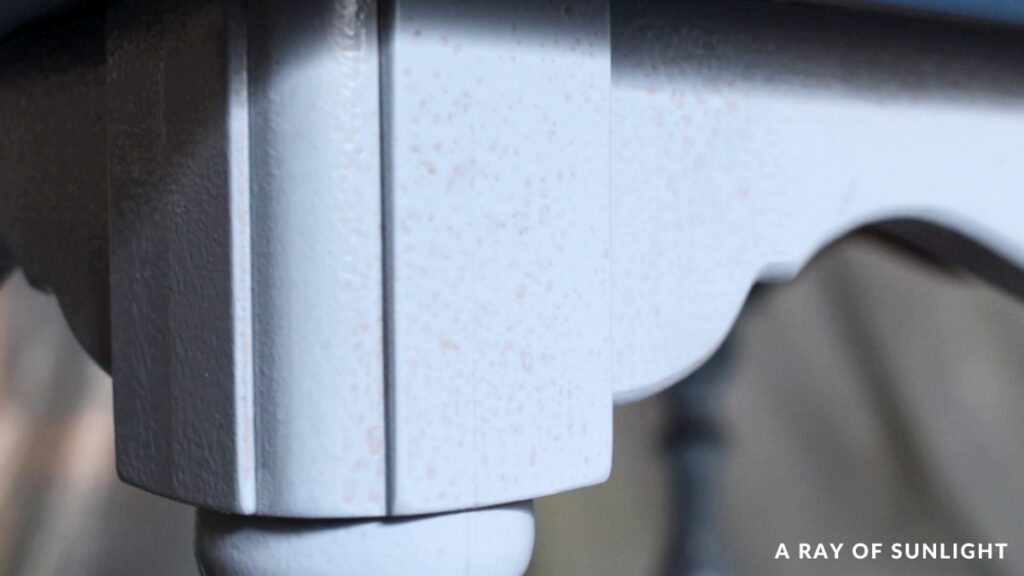
Even though I used a sprayer here, this paint is one of my favorites to brush on.
It’s acrylic based and so it self levels, leaving behind a brush free finish. Especially if you add a little bit of water to the paint before brushing it on.
So don’t be afraid to brush it on if that’s what your situation warrants.
I painted on another coat of paint, and then I let it all dry for about 24 hours.
How to Use Waverly Antique Wax
It’s very important to let the Waverly chalk paint dry for at least 24 hours before using wax, so you can let the chalk paint start to cure.
Otherwise it will easily rub off when you rub on the wax… especially if you don’t prime before painting.
Then, working in small sections at a time, I applied a coat of clear wax with a chip brush in a small section. I made sure to get it all over.. and then I wiped off the excess with a lint free rag.
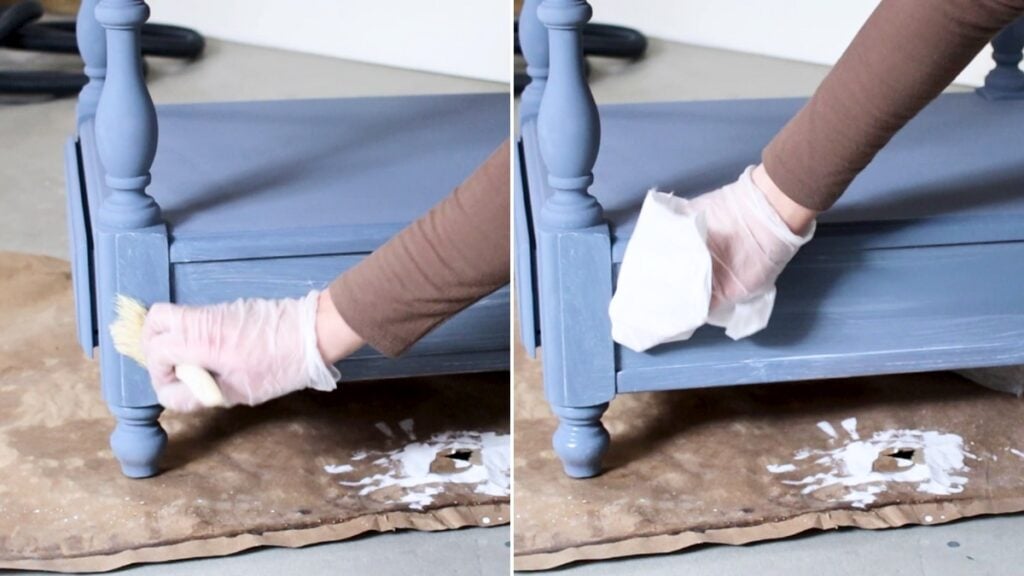
Immediately after, I brushed the antique wax on with a different brush, in the corners and details. And then I wiped the excess away with the same cloth.
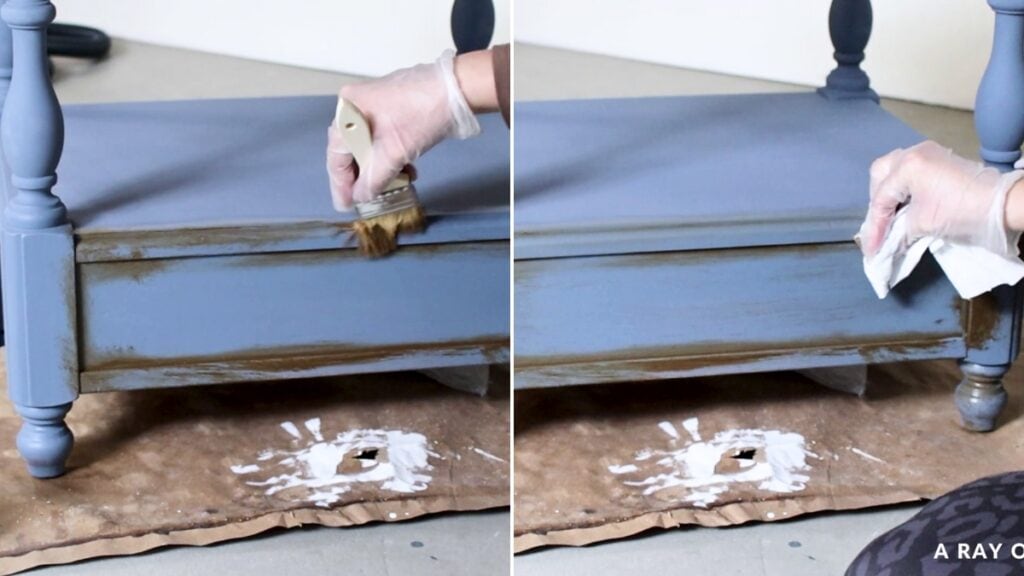
When there was too much antique wax for my liking, I brushed on some clear wax, and it wiped the dark wax away.
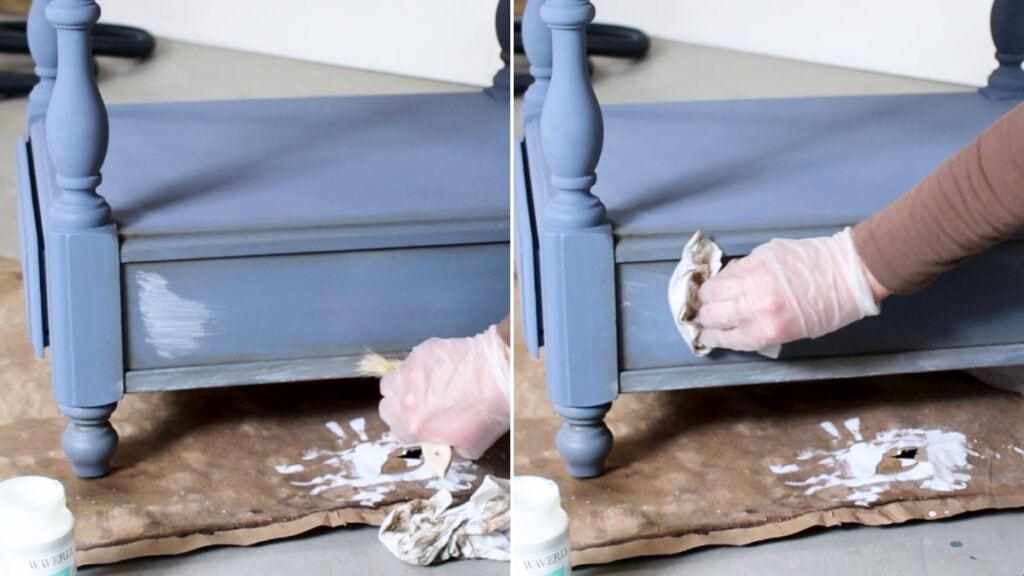
I did this technique on all of the chalk painted areas. Check out my detailed guide on how to apply Waverly wax over chalk paint here and how to use Waverly antique wax here.
Usually wax feels really tacky to me for at least a few days, but this combination dried quickly. And I was really pleased with the thin consistency of this wax.
See the difference between wax vs polyurethane here. Learn about wax for chalk paint here.
Staining Wood with Lilly Moon Gel Stain
Then I removed the plastic from the top of the table and applied some Lilly Moon smoky gel stain onto the raw wood with another lint free rag.
I’ve never used this stuff before, and it was given to me. But I thought the color would go perfectly with the base of the table.
Since I applied it onto raw wood, it soaked in a dried really quickly, so it ended up looking kind of splotchy and uneven.
I tried putting some more on in the places that were darker to remove some of it. I don’t know if it helped or made it worse.
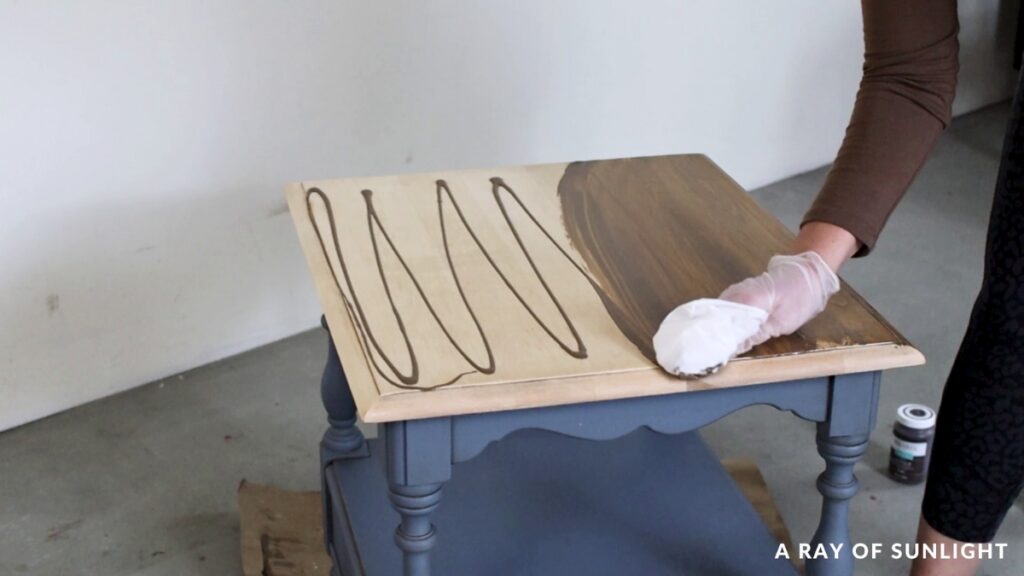
So I stopped and let it dry. If it was terrible, I could sand it off and try again.
When it was dry, it didn’t look terrible, so I just lightly sanded it with a fine grit foam pad to soften the streaks. Then I put on another coat of the gel stain, trying to work faster this time.
After that was dry, I brushed on a few coats of waterbased polyurethane to give it a durable finish.
Since I have multiple sheens in my workshop, I used satin first, and then finished with the matte sheen, so it would match the rest of the matte looking table.
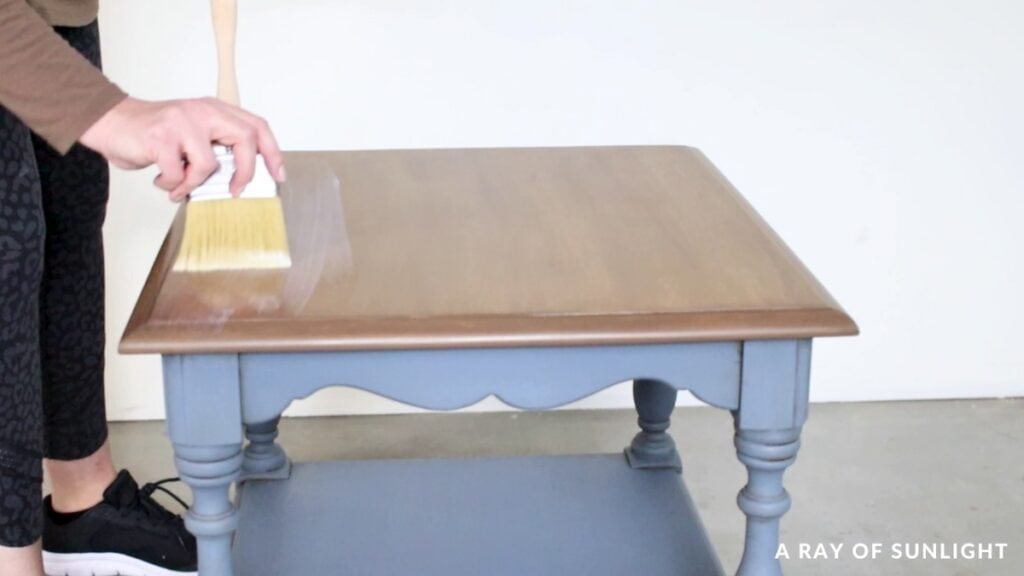
A satin finish is more durable than a matte finish, so the first coat of satin gave it a slightly more durable finish than if I would have just used a matte finish for all of the coats of topcoat.
Watch the full tutorial on using Waverly chalk paint and antique wax:
Last but not least, I found an old drawer pull in my stash of hardware, so I attached it to the drawer, and here’s what it looks like now!
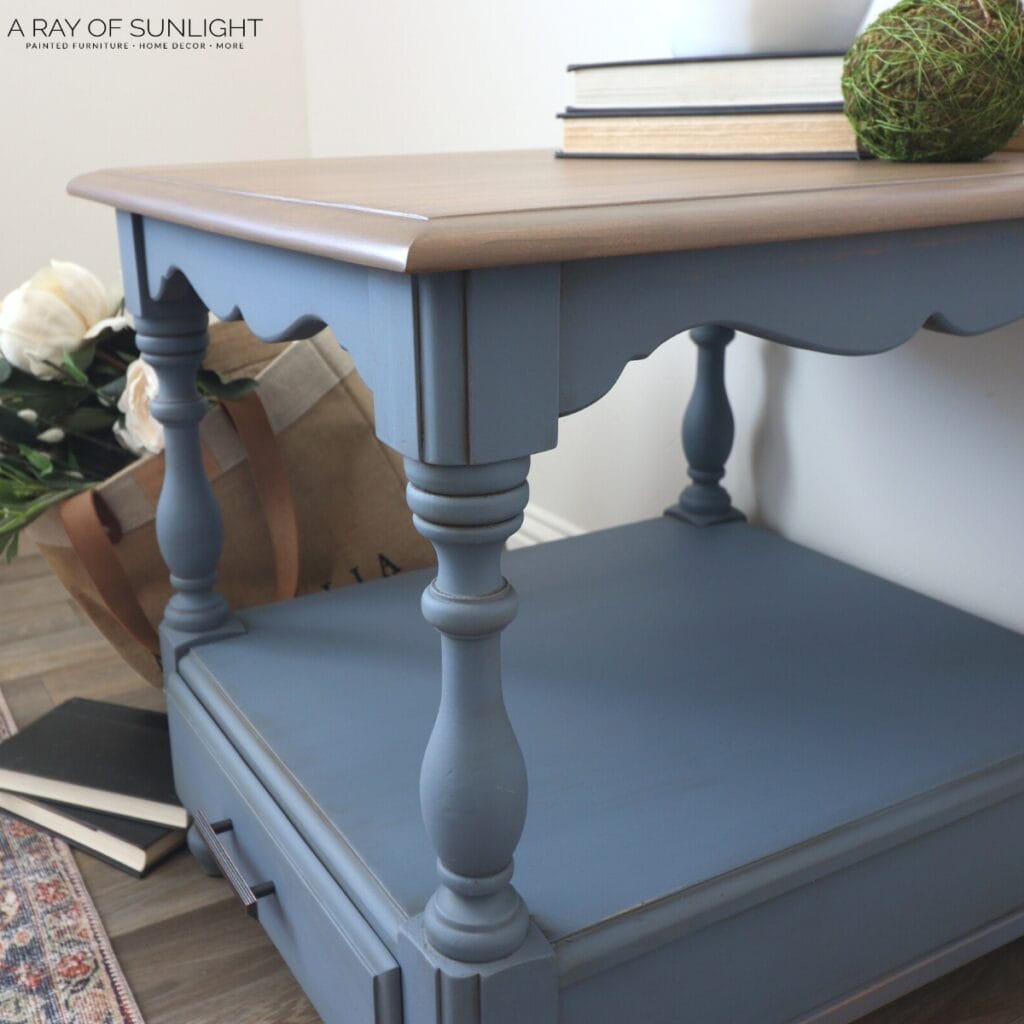
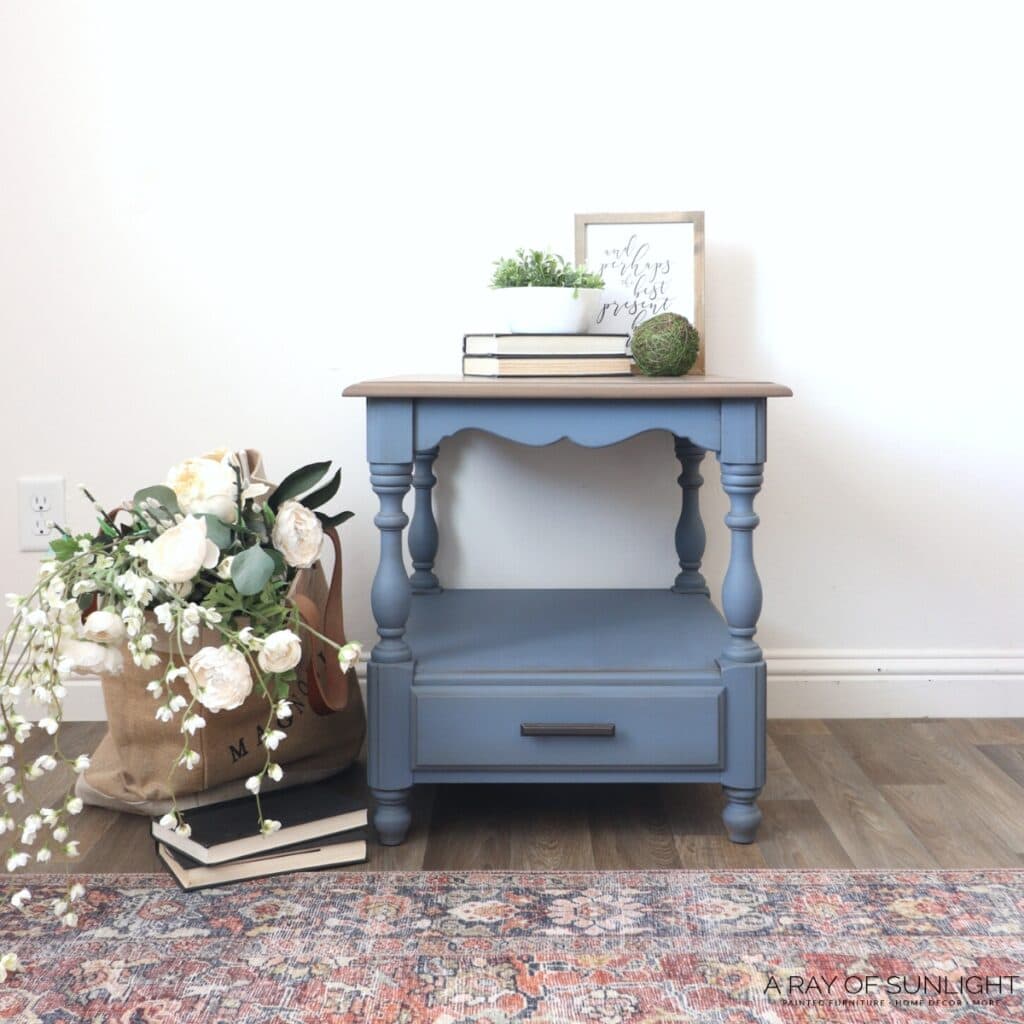
More Before And After Makeovers
Click any of these “before” photos below to view the “after” of that makeover.
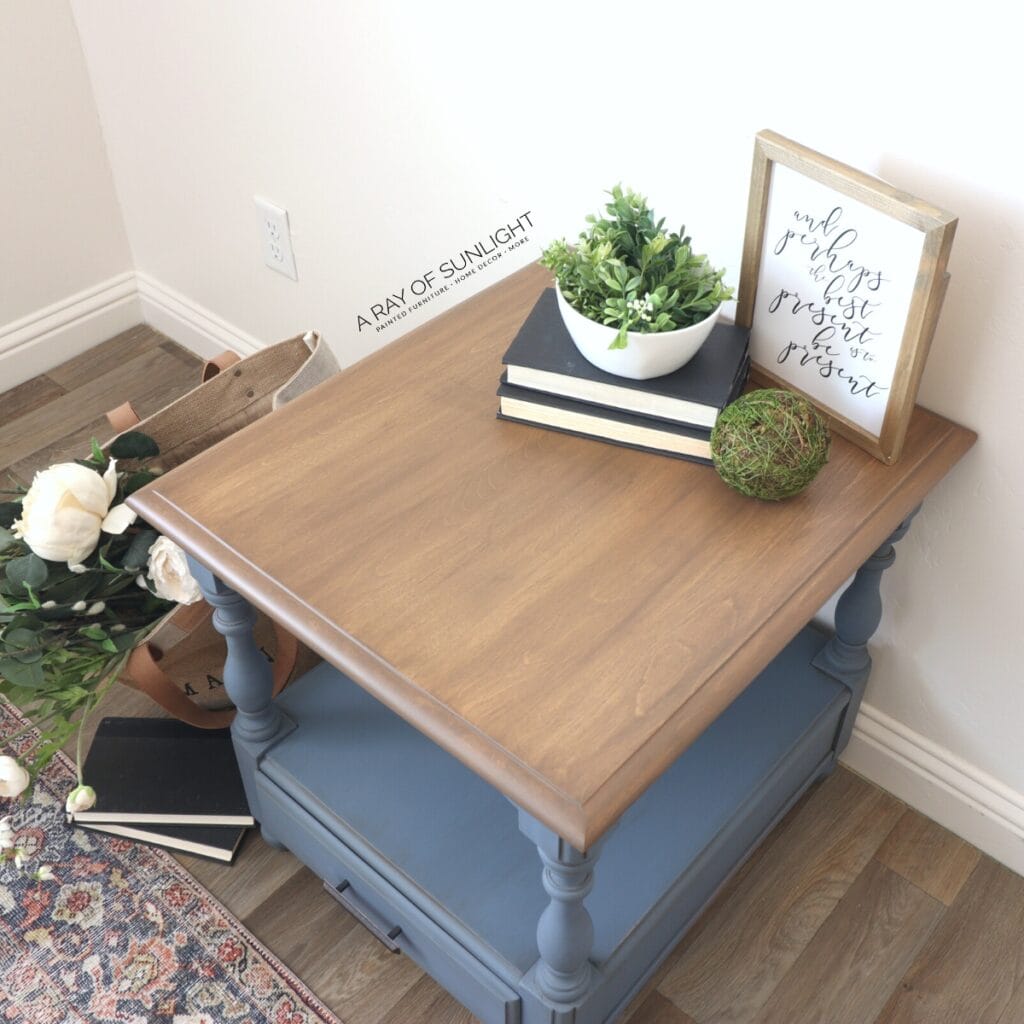
This French looking finish isn’t necessarily my style, for my home right now, but I love the look of it on this table. What do you think of the new look? Does it match your décor in your home?
More Waverly Chalk Paint Resources
- Waverly Chalk Paint Review
- Chalk Painting Furniture Black
- Waverly Chalk Paint: Everything You Need to Know
Follow us on YouTube to get more tips for painting furniture.
Or share your project with us on our Facebook Group and be part of our community. See you there!

